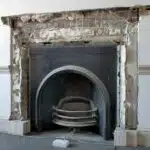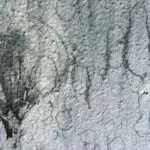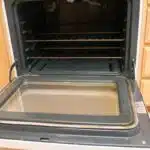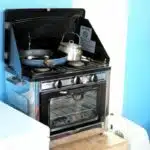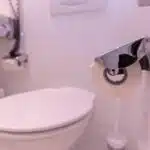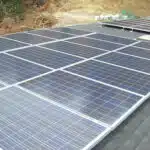As a fireplace cleaning specialist, it is essential to understand the importance of maintaining a clean and safe fireplace. A dirty fireplace can be hazardous as it can cause chimney fires, emit toxic gases, and decrease the efficiency of your heating system. Therefore, it is crucial to know how to clean a fireplace correctly.
Cleaning a fireplace requires patience and attention to detail. It is not only about removing the ashes and soot but also inspecting the chimney for any potential hazards. In this article, we will discuss step-by-step instructions on how to clean a fireplace effectively while ensuring its safety and longevity. By following these guidelines, you can maintain your fireplace’s health and enjoy the warmth and ambiance it provides without worrying about any risks or hazards.
Why Fireplace Cleaning Is Important
Regular maintenance of your fireplace is crucial to ensure its longevity and safety. Many homeowners overlook the importance of keeping their fireplace clean and assume that it will function properly without regular upkeep. However, a dirty fireplace can pose several health hazards and increase the risk of fire accidents.
One of the main reasons why cleaning your fireplace on a regular basis is important is to avoid the buildup of creosote. Creosote is a highly flammable substance that forms when wood burns, and it can accumulate in your chimney over time. If left unattended, this buildup can cause chimney fires that can quickly spread to other parts of your home.
In addition to creosote buildup, a dirty fireplace can also lead to the production of harmful gases such as carbon monoxide. Carbon monoxide is an odorless gas that can be deadly if inhaled in large amounts. When you burn wood in your fireplace, it produces carbon monoxide, which should be safely vented out through your chimney. However, if there are blockages or obstructions in your chimney, this gas can leak into your home and pose a serious risk to you and your family.
Understanding the risks associated with a dirty fireplace is essential for maintaining a safe and healthy living environment. By regularly cleaning and maintaining your fireplace, you can ensure that it functions efficiently and safely for years to come.
Understanding The Risks Of A Dirty Fireplace
As a professional fireplace cleaning specialist, it is important to emphasize the dangers that come with neglecting your fireplace. A dirty fireplace can pose serious health and safety risks to you and your loved ones. The buildup of creosote, soot, and other debris can increase the risk of a chimney fire. Additionally, carbon monoxide poisoning can occur if the chimney is not properly ventilated.
Regular maintenance of your fireplace is crucial in preventing these potential hazards. It is recommended that you have your chimney inspected and cleaned at least once a year by a professional. This will ensure that any buildup or blockage in the chimney is removed, reducing the risk of a fire or carbon monoxide poisoning. Furthermore, regular maintenance can also extend the life of your fireplace and save you money on costly repairs.
In summary, understanding fireplace dangers and the importance of regular maintenance cannot be overstated. Neglecting your fireplace can lead to serious health and safety risks for you and your family. By taking proactive measures such as scheduling annual inspections and cleanings, you can protect yourself from potential hazards while also prolonging the lifespan of your beloved fireplace.
Moving forward, it’s important to know what tools are necessary for proper fireplace cleaning.
Necessary Tools For Fireplace Cleaning
Did you know that in the United States, there are over 20,000 residential fires caused by fireplaces and chimneys each year? This statistic highlights the importance of regularly cleaning your fireplace to ensure the safety of your home. To effectively clean your fireplace, you will need a few necessary tools.
One option is to purchase top brands for fireplace cleaning tools such as chimney brushes, ash vacuums, and creosote removers. These high-quality tools can make the cleaning process much easier and more efficient. However, if you are on a tight budget or prefer a DIY approach, there are many household items that can be used to clean your fireplace such as baking soda and vinegar.
While DIY methods may seem cost-effective, it is important to note that professional fireplace cleaning services have access to specialized equipment and expertise that can thoroughly clean your chimney and detect any potential hazards. If you are unsure about how to properly clean your fireplace or do not feel confident in doing so yourself, consider hiring a professional cleaner who can provide a safe and effective cleaning service for your home.
Transitioning into preparing for cleaning: Before starting the actual cleaning process, it is important to prepare your workspace properly.
Preparing For Cleaning
Before cleaning a fireplace, it is essential to prepare the area and gather the necessary tools and supplies. First, remove any debris or ash from the fireplace using a shovel or brush. Place this debris in a metal bucket and dispose of it safely. Next, gather all the cleaning supplies needed for the job, including a stiff-bristled brush, vacuum cleaner with a HEPA filter, and cleaning solution.
When preparing for fireplace cleaning, it is crucial to prioritize safety by wearing protective gear. This includes gloves, safety goggles, and a dust mask. The gloves protect your hands from fire hazards and sharp edges while handling debris. Safety goggles shield your eyes from flying ash particles or any chemicals in the cleaning solution that could cause irritation. Lastly, a dust mask protects your respiratory system from inhaling harmful soot or ash particles.
To ensure that your fireplace cleaning process goes smoothly without any interruptions, make sure you have all the necessary items gathered before starting. A well-prepared workspace will allow you to focus solely on the task at hand without worrying about searching for missing items or running out of supplies midway through the process. With proper preparation and attention to safety measures taken into account beforehand, you can rest assured that your fireplace cleaning will be both efficient and effective.
As you prepare yourself with the necessary tools and take precautions to keep yourself safe during the process, you are now ready to move onto removing ashes and soot. Properly removing these components is crucial for ensuring optimal performance from your fireplace while also avoiding any potential health risks associated with inhaling these substances.
Removing Ashes And Soot
After preparing for the cleaning process, it is essential to follow safety measures when removing ashes and soot from the fireplace. Safety goggles, gloves, and a dust mask are necessary to prevent inhalation of ash or soot particles. A drop cloth should be placed around the fireplace to avoid spreading debris throughout the room. It is also crucial to wait at least 24 hours after extinguishing a fire before attempting to clean the fireplace.
Disposal methods for ash and soot should be carefully considered as well. Ashes can remain hot for up to three days after being removed from a fireplace, so they should be stored in non-flammable containers with tight-fitting lids. Once cooled, they can be disposed of in outdoor trash bins or used as fertilizer for plants that thrive in alkaline soil. Soot can easily spread throughout the room, so it is recommended to use a vacuum with a HEPA filter instead of sweeping.
By following these safety measures and disposal methods, you can efficiently remove ashes and soot from your fireplace without any harm. In addition to providing warmth and comfort during colder months, keeping your fireplace clean ensures optimal functionality and reduces the risk of potential fire hazards. The next step in the cleaning process involves scrubbing the interior of the fireplace using appropriate tools and techniques.
Scrubbing The Fireplace Interior
With the interior of the fireplace free of ashes, it is time to get scrubbing. First, gather your cleaning materials such as a stiff-bristled brush, vacuum cleaner with hose attachment, and a bucket of warm water mixed with mild soap. To avoid leaving scratches on the surface, ensure that the brush is made of soft bristles.
Next, dip the brush in soapy water and start scrubbing from top to bottom in a circular motion. Ensure that you apply enough pressure to remove all the soot buildup on the walls. Continue until all visible areas are clean. You may also use a sponge to clean hard-to-reach areas such as corners.
- Remember to wear protective gear such as gloves and goggles when cleaning.
- For tougher stains, consider using specialized cleaning products made for fireplaces.
- Avoid using abrasive cleaners or tools such as steel wool or sandpaper.
- For natural solutions, mix vinegar with water in equal parts and use it to scrub off stains.
By following these DIY tips and using the best products available, cleaning your fireplace interior can be easy and effective. A well-maintained fireplace not only adds aesthetic value to your home but also ensures that it functions safely during colder months.
As we move forward into cleaning the grate and firebox section, it’s important to note that regular maintenance will increase its longevity while enhancing its efficiency.
Cleaning The Grate And Firebox
After scrubbing the interior of your fireplace, it’s time to move on to cleaning the grate and firebox. This step is crucial in ensuring that your fireplace functions properly and maintains its aesthetic appeal. Here are some cleaning techniques you can use to effectively clean these areas:
Grate: The grate is where the logs sit inside your fireplace. To clean it, remove any ashes or debris with a brush and dustpan. Then, use a wire brush to scrub away any built-up soot or creosote. Finally, wipe down the grate with a damp cloth.
Firebox: The firebox is the area surrounding the grate where the logs burn. To clean it, start by removing any ash or debris with a brush and dustpan. Next, use a wire brush or scraper to remove any stubborn soot or creosote buildup. Finally, wipe down the firebox with a damp cloth.
While cleaning your fireplace may seem like a simple task, it’s important to take certain safety measures to ensure that you don’t damage yourself or your property. Always wear gloves and protective eyewear when handling ashes or using cleaning products. Additionally, make sure that your chimney is properly ventilated before starting any cleaning process.
Inspecting the chimney is an essential part of maintaining your fireplace’s functionality and safety. In order to ensure that there are no blockages or damage to your chimney liner, it’s important to hire a professional chimney sweep at least once per year. By following these cleaning techniques and safety measures, you can enjoy a beautiful and functional fireplace all winter long!
Inspecting The Chimney
After cleaning the fireplace, it is important to inspect the chimney for any damage or debris. A thorough chimney inspection can help prevent fires and ensure that your fireplace is functioning properly. It is recommended that homeowners have their chimneys inspected at least once a year by a professional chimney sweep.
During a chimney inspection, the sweep will check for any cracks or holes in the flue lining, as well as any buildup of creosote or other debris. They will also check for any signs of animal nesting or blockages that could impede airflow. To ensure that your chimney stays in good condition throughout the year, there are several maintenance tips to keep in mind.
Firstly, never burn anything other than wood in your fireplace. Burning trash or other materials can create dangerous fumes and increase the risk of a chimney fire. Secondly, use seasoned hardwoods rather than softwoods, which produce more creosote when burned. Finally, never leave a fire unattended and always make sure your damper is open before lighting a fire.
With proper maintenance and regular inspections, you can enjoy your fireplace safely and efficiently all winter long. The next step in maintaining your fireplace is removing creosote buildup, which we will discuss in further detail in the next section.
Removing Creosote Buildup
Now that we have inspected the chimney, it’s time to move on to the next step of cleaning your fireplace. A crucial step in maintaining a clean and safe fireplace is preventing creosote buildup. Creosote is a highly flammable substance that can accumulate in the chimney and lead to chimney fires. To prevent this buildup, it’s essential to burn only dry and seasoned wood, and avoid burning trash or other materials.
Once you have ensured that there is no significant creosote buildup in your chimney, you can begin cleaning your fireplace using cleaning solutions. There are several types of cleaning solutions available in the market, including sprays, powders, and liquids. Always follow the manufacturer’s instructions when using these products. It’s crucial to wear gloves and eye protection while handling these chemicals.
When using cleaning solutions, always start with a small amount and apply it to the surface of your fireplace. Let it sit for a few minutes before scrubbing with a stiff-bristled brush. After scrubbing thoroughly, rinse off the solution with water and let it dry completely before lighting any fires. By regularly cleaning your fireplace with proper cleaning solutions, you can ensure that it stays free from stains and odors.
Next up: addressing stains and odors caused by prolonged use of your fireplace.
Addressing Stains And Odors
How do you address stubborn stains and smoky odors in your fireplace? Removing persistent discolorations from masonry and brick fireplaces can be a challenging task. For starters, you may need to use a specialized cleaning agent that is specifically designed for tackling tough stains. You can find such cleaners at your local hardware or home improvement store.
When dealing with smoky odors, start by inspecting the chimney flue and cap for any obstructions, such as bird nests or debris. If there are no visible blockages, try using an odor eliminator spray that is safe for use on fireplaces and chimneys. Additionally, consider burning small amounts of wood with high heat output to reduce the buildup of creosote in the chimney interior.
To eliminate smelly stains in your fireplace, create a paste using water and baking soda. Apply this mixture to the affected area and let it sit for several hours before scrubbing it clean with a stiff-bristled brush. Afterward, rinse the spot with warm water and dry it thoroughly. Remember to wear protective gloves and goggles while cleaning your fireplace.
Next up: dealing with difficult-to-clean fireplaces!
Dealing With Difficult-To-Clean Fireplaces
After addressing the stains and odors in your fireplace, it’s time to move on to cleaning the fireplace itself. Before beginning this task, it’s important to gather all necessary cleaning tools and protective gear. This includes gloves, safety glasses, a dust mask, a stiff brush, a vacuum cleaner with an extension hose and brush attachment, and a metal scoop.
To begin the cleaning process, start by removing any remaining ashes or debris from the fireplace using the metal scoop. Once all debris has been removed from the fireplace, use the stiff brush to scrub away any remaining soot or residue from the walls of the fireplace. Be sure to wear gloves and a dust mask during this process as soot can be harmful if inhaled.
After scrubbing away all residue from the walls of the fireplace, use your vacuum cleaner with an extension hose and brush attachment to remove any remaining dust or debris from inside of your fireplace. With these steps completed, you should now have a clean and safe-to-use fireplace.
Maintaining a clean fireplace is essential for keeping your home safe and comfortable during colder months. To avoid needing to tackle difficult-to-clean fireplaces in future seasons, it’s recommended that you clean your fireplace every few weeks when in use. Additionally, consider investing in a good quality ash bucket or pan to make disposing of ashes easier and less messy.
Maintaining A Clean Fireplace
- Sweeping ashes from a fireplace should be done regularly to keep the area clean and minimize the risk of fire.
- Cleaning the firebox should be done by carefully removing the ashes and soot buildup with a stiff brush.
- Fire grates should be inspected regularly for any signs of wear and tear and replaced if necessary.
- It is important to use a vacuum cleaner with a proper filter or a dustpan and brush to sweep the ashes from the firebox.
- For thorough cleaning, scrub the firebox with a solution of water and baking soda or a commercial rust-remover.
- If the grates are badly worn, they should be replaced to ensure a safe and efficient burning of firewood.
Sweeping Ashes
Sweeping ashes is an important step in maintaining a clean fireplace. As a fireplace cleaning specialist, I highly recommend using a metal scoop or shovel to remove ashes from the firebox. This not only prevents damage to the fireplace but also reduces the risk of accidental fires caused by hot embers.
Disposal options for ashes include placing them in a metal container with a tight-fitting lid and storing them outside away from flammable objects. It is crucial to avoid disposing of ashes in plastic bags or cardboard boxes as they can ignite easily and cause severe damage. Safety measures should always be observed when handling ash containers, as embers can remain hot for several hours even after the fire has been extinguished.
In conclusion, sweeping ashes is an essential part of maintaining a clean and safe fireplace. By following proper disposal options and safety measures, homeowners can enjoy the warmth and ambiance of their fireplaces without worrying about potential hazards caused by hot embers. As a fireplace cleaning specialist, I encourage everyone to practice caution and maintain regular upkeep of their fireplaces for optimal performance and longevity.
Cleaning The Firebox
Maintaining a clean fireplace is crucial for the safety of homeowners and their homes. One important aspect of fireplace maintenance is cleaning the firebox regularly. This involves vacuuming ashes and removing debris to prevent blockages that can lead to poor performance and hazardous situations.
As a fireplace cleaning specialist, I recommend using a high-quality vacuum specifically designed for fireplace use. This ensures that all ashes and debris are effectively removed from the firebox without causing any damage. It is essential to avoid using regular household vacuums as they are not equipped to handle the fine particles of ash.
Regular cleaning of the firebox also helps improve airflow, which in turn enhances combustion efficiency and reduces emissions. It is advisable to clean the firebox at least once a week or after every use, depending on how frequently the fireplace is used.
By prioritizing regular cleaning and maintenance of their fireplaces, homeowners can enjoy a safe and efficient heating source that adds warmth and ambiance to their homes. As always, it is essential to observe safety measures when handling ashes and other debris from the firebox to prevent accidental fires or injuries.
Replacing Grates
Grate maintenance is an essential part of fireplace maintenance. Over time, grates can become worn out or damaged, leading to poor performance and potential safety hazards. As a fireplace cleaning specialist, I recommend replacing grates every two to three years or as needed.
When choosing grates, it is crucial to consider the type of fuel used in the fireplace. Grates come in different materials such as cast iron, steel, and stainless steel. Cast iron grates are excellent for burning wood because they can withstand high temperatures and are durable. Steel grates are ideal for gas fireplaces as they do not corrode easily. Stainless steel grates are suitable for both wood and gas fireplaces due to their resistance to corrosion and durability.
Replacing old or damaged grates not only ensures optimal performance but also improves the appearance of the fireplace. It is essential to choose a grate that fits well and complements the overall design of the fireplace. A properly fitted grate allows for better airflow, which enhances combustion efficiency and reduces emissions.
In conclusion, maintaining a clean fireplace involves more than just cleaning the firebox regularly; it also includes replacing worn-out or damaged grates when necessary. By following these steps, homeowners can enjoy a safe and efficient heating source that adds warmth and ambiance to their homes while also serving others by ensuring their safety.
Professional Fireplace Cleaning Services
As a professional fireplace cleaning specialist, I have seen firsthand the benefits of utilizing a professional cleaning service. Not only does it save time and effort on the part of the homeowner, but it also ensures a thorough and effective clean that cannot be achieved through DIY methods. In addition to its cost effectiveness, hiring a professional cleaning service can extend the lifespan of your fireplace and prevent potential hazards such as chimney fires.
One of the primary benefits of utilizing a professional cleaning service is the cost effectiveness it provides. While some homeowners may attempt to clean their own fireplace, they often lack the necessary tools and expertise to do so effectively. This can result in an insufficient clean that requires additional time and money to remedy. Hiring a professional cleaning service not only saves homeowners from this hassle but also helps them avoid potential damage to their fireplace or chimney.
Ultimately, safety should always be a top priority when it comes to maintaining your fireplace. This is especially true during cleaning, as failure to take proper precautions can result in serious injury or even death. In our subsequent section about safety precautions during fireplace cleaning, we will delve deeper into the necessary steps homeowners should take when attempting to clean their own fireplace. By following these guidelines and investing in a professional cleaning service when needed, homeowners can enjoy all the benefits of having a well-maintained fireplace without sacrificing their safety or financial well-being.
Safety Precautions During Fireplace Cleaning
When it comes to cleaning your fireplace, safety should always be a top priority. One of the most important safety precautions you can take is wearing gloves while cleaning. Fireplace cleaning can expose you to harmful substances like soot and creosote, which can irritate your skin and cause other health problems. Wearing gloves will protect your hands from these substances and reduce the risk of injury.
Another critical safety measure when cleaning your fireplace is wearing protective eyewear. This is especially important if you plan on using any chemicals or cleaning agents to remove stubborn stains or buildup. Protective eyewear will help shield your eyes from harmful fumes and debris that may become airborne during the cleaning process.
In summary, wearing gloves and protective eyewear are both essential for maintaining safe conditions while cleaning your fireplace. By following these precautions, you can help ensure that you don’t suffer any injuries or health problems as a result of exposure to harmful substances. So before you start cleaning your fireplace, make sure to put on the proper gear to keep yourself protected!
Moving forward into the next section, we will discuss some common issues that homeowners face when trying to clean their fireplaces. These issues can range from simple problems like dirty glass doors to more complex ones like clogged chimneys or damaged brickwork. In order to address these issues effectively, it’s important to understand their root causes and how they can be resolved. Let’s dive in and explore some of the most common issues that arise during fireplace cleaning!
Troubleshooting Common Fireplace Cleaning Issues
Like a puzzle that requires patience and skill, cleaning a fireplace can be a challenging task. As a proficient fireplace cleaning specialist, I understand the various issues homeowners face when trying to maintain their fireplaces. In this section, we will explore common issues that arise during fireplace cleaning and how to troubleshoot them.
One of the most frustrating problems homeowners encounter is smoke issues. Smoke can fill your home with an unpleasant odor and cause respiratory issues. To prevent this problem, ensure that your chimney is functioning correctly and free from debris buildup. If you still experience smoke buildup, check for clogs in your flue or chimney cap, which may be obstructing proper ventilation.
Another issue that many people face is removing stubborn stains from their fireplace surfaces. These stains can accumulate over time and become increasingly difficult to remove if not addressed promptly. One effective solution for eliminating stubborn stains is using a mixture of baking soda and water to create a paste-like consistency. Apply the paste to the stained area and let it sit for several minutes before wiping it away with a damp cloth.
In conclusion, keeping your fireplace clean involves more than just sweeping out ashes and wiping down surfaces. By troubleshooting common issues such as smoke buildup and stubborn stains, you can ensure that your fireplace is safe, functional, and visually appealing all year round. Remember to conduct regular maintenance checks on your chimney system to avoid these issues from arising in the first place!
Conclusion
Fireplace cleaning is an essential task that should not be overlooked. A dirty fireplace can pose many risks, including health hazards and even fire hazards. Understanding the importance of fireplace cleaning and having the necessary tools to do so is crucial. Preparing for cleaning by covering surrounding areas and wearing protective gear is also important.
Removing ashes and soot from a fireplace may seem like a simple task, but it requires attention to detail and safety precautions. Maintaining a clean fireplace regularly will prevent buildup and make cleaning easier in the future. Professional fireplace cleaning services are available for those who prefer to leave it to the experts.
As a fireplace cleaning specialist, I cannot stress enough the importance of taking safety precautions during this process. Troubleshooting common issues such as stubborn soot stains or debris stuck in hard-to-reach places is also an essential part of maintaining a clean fireplace. In conclusion, keeping your fireplace clean is not only aesthetically pleasing but also crucial for maintaining a safe and healthy living environment. As they say, “a clean hearth makes for a happy home.”
Image Credits
- “Fireplace” by HomeSpot HQ (featured)


